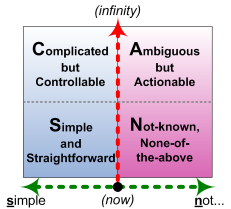Link: http://weblog.tetradian.com/2013/03/14/more-keywords-for-scan/
Some notes that came up for me almost a month back, on the SCAN framework for sensemaking and decision-making, and that I hadn’t gotten round to documenting until now.
I was reminded that I hadn’t posted these notes when I saw Mark Foden refer to the Cynefin framework in his talk at the Integrated EA conference, to illustrate the difference between a context that’s merely complicated, and one that’s genuinely complex – the latter often because it includes a variety of ‘people-issues’ and suchlike. The Cynefin framework is quite useful for illustrating that difference.
Yet over the past few years – as I’ve described in quite a few of my previous posts, such as ‘A human view of Simple, Complicated and Complex‘, and ‘Ensuring that the Simple stays simple‘ – I’ve become increasingly wary of the term ‘complex’: the problem is not in the term itself, but in the fact that people interpret it in so many different ways. For example, much of what IT-folks might call ‘complexity’ – because it’s, well, complex, isn’t it? – would be described instead by aficionados of complexity-science merely as high levels of ‘complicatedness’ – the key distinction being that it expects a predictable and repeatable result. Hence a lot of unnecessary confusion and, occasionally, heated argument, that really doesn’t help anyone at all. That’s one of the key reasons why, in SCAN, I switched over to using ‘Ambiguous’ instead: it’s perhaps not as precise a term as ‘complex’, but at least it’s unambiguous about the existence of the ambiguous! ![]()
Which brings me back to those notes, because I’d been building small collection of alternate keywords for each of the ‘domains’ in SCAN. None of these keywords replace anything: it’s just that, following the same principles of context-space mapping that underlie SCAN itself, they add extra layers of richness to the sensemaking by providing a kind of contrast, cross-reference, cross-check and suchlike. Anyway, here’s the list so far:
‘S‘ domain: Simple and Straightforward (high-repeatability, at or near moment of action):
- Step-by-step
- Speed [don’t feel, don’t think, just do]
- Switch [as in predefined flowchart, ‘no thinking required’]
‘C‘ domain: Complicated but Controllable (high-repeatability, at distance from moment of action):
- Correct
- Calculable
- Certain
- Controllable
- Confirmable
- Conformity
- Compliance
- Certifiable
‘A‘ domain: Ambiguous but Actionable (low-repeatability, at distance from moment of action):
- Adaptable
- Adjustable
- Amenable
- Assessable
- Ask [as in the uncertainty of experimentation, rather than the (apparent) certainty of calculation]
- Angst-laden!

‘N‘ domain: Not-known, None-of-the-above (low-repeatability, at or near moment of action):
- No idea
- No time to think
- Newness [as in (near)-unique, therefore no certain rules]
Any other suggestions that you’d add to this?
